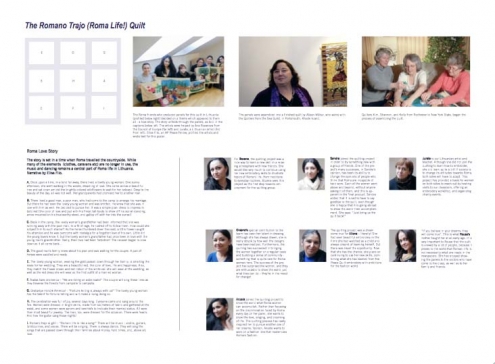Romano Trajo (Roma Life) Quilt
Background
Background
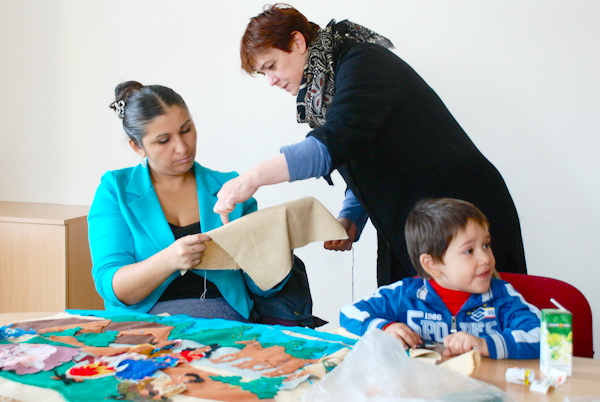 Jurate, center, a Lithuanian artist produced a square and helped the other quilters with their designs. By early 2012, AP had worked with Roma groups to produce four striking advocacy quilts. Over thirty Roma women in three European countries had produced squares. These were then assembled in the US, and widely shown in the US and Europe. It suggested that quilting offered Roma women a splendid outlet for their energy and skills. Encouraged, AP decided to use what remained of our small grant from the previous year to invest in another Roma project. We approached Ana Rozanova, an official at the Council of Europe who had worked on the Dosta! quilt in 2011. Ana suggested her own country, Lithuania. During a visit to Vilnius, Ana met with leaders of the Roma Community Center (RCC) and sounded them out. They liked the idea, but recommended against working from the largest Roma settlement center at Kirtimai, where the RCC had an office. Instead, Ana met with a small group of professional women who jumped at the opportunity. AP recruited Elise Filo, a Brazilian-American who had worked with Roma in East Europe, to work alongside Ana as a Peace Fellow during the summer. Ana secured a small grant from the Open Society Arts and Culture Program (Hungary), and the project was off and running. Like other quilting projects, it began with a brainstorm. The artists decided on a good old-fashioned love story, set in a bygone era when Lithuanian Roma traveled by horse. The story unfolds through nine lively panels: A lovely young Roma woman sits dreaming of love in the forest; unknown to her a poor young man is in love with the young woman; her grandfather plots to marry her off, until he realizes that he was once in love with the young man’s grandmother; the young couple are united and married in a grand ceremony. Elise described it all in exuberant prose for the accompanying poster: “There were feasts. And how the guitar sang those nights!“ 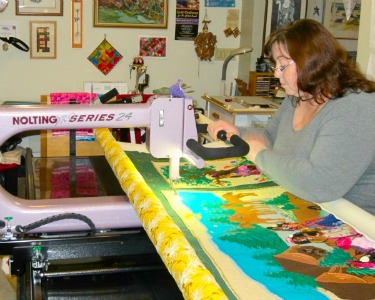 Allison Wilbur re-assembled the squares into the final quilt at her home in Rhode Island. Helped by Jurate, a Lithuanian artist, each of the women produced a tile and then worked together on a large tile which depicts the marriage ceremony At this point they began to run out of brown tread and also realized that there were more horses than people in their grand design. They dealt with the first problem and ignored the second. By now, word had got around. Gražina Sluško, a Senior Specialist at the Ministry of Culture stopped by to take a look and explore the possibility of cooperating on future events promoting Romani culture. Nina Murray, Cultural Attache of the US Embassy in Vilnius, came to learn more about the project and even contributed to the stitching. (The US Embassy has helped the Roma community in Vilnius through a program known as CULP, in which US Military Cadets teach English to different local groups.) Even when the quilt was finished, the artists were unwilling to quit. They made twenty small framed wall hangings which were sent to AP to be exhibited and even sold. Elise continued to take excellent photos and produce blogs. Finally, when it was all over, Elise collected the tiles and brought them back to her mother, Kelly, in Rochester New York. Kelly, a quilter, assembled a rough quilt and Alison Wilbur, an experienced quilter from Rhode Island who worked with AP on several previous projects, finished off the job. The quilt was then unveiled for the first time at the Kean University on January 1, 2013, alongside the four other Roma quilts. Romany life was finally in view, in all its romantic glory. |
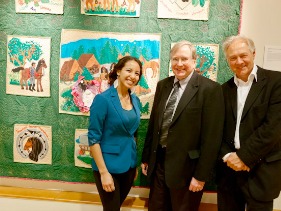 On Display in New Jersey: Janine Rivera (left), a student, and Professor Hank Kaplowitz (center) helped to coordinate the Kean University exhibition in 2013. They are shown standing in front of the Roma Life quilt. |
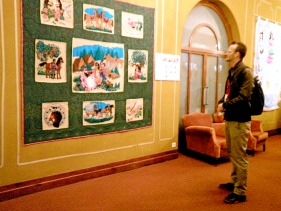 On Display in Marseilles: Four of the Roma advocacy quilts were displayed at the Italian Institute of Culture, in Marseilles France, in November 2013. |
Artists
Artists
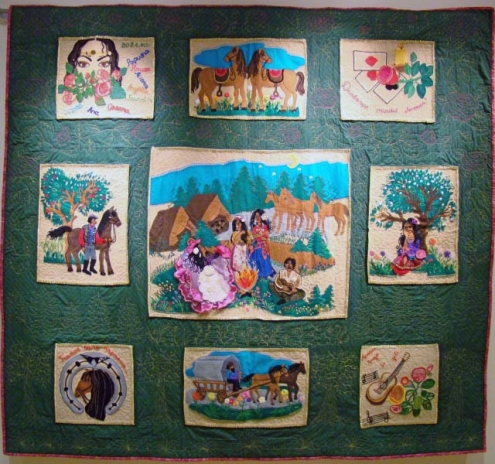
Roma Love Story The story is set in a time when Roma travelled the countryside. While many of the elements (clothes, caravans etc) are no longer in use, the music and dancing remains a central part of Roma life in Lithuania. Narrative by Elise Filo. |
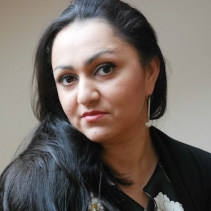 |
Bozena For Bozena, the quilting project was a nice way to learn a new skill in a relaxing atmosphere with new friends. She would like very much to continue using her new embroidery skills to illustrate topics of Romani life, from traditions to everyday routines. Bozena sees this project as the first step towards employment for the quilting group. |
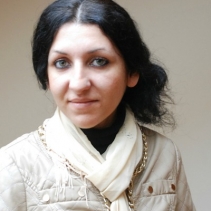 |
Sandra Sandra joined the quilting project in order to try something new with a group of friends. One of the project’s many successes, in Sandra’s opinion, has been its ability to change the opinions of people who think that Roma are incapable of hard work. Each of the women went above and beyond, without anyone asking it of them, and this is apparent in the final product. Sandra added that it is sad to have to say goodbye to the quilt, even though she is happy that it is going abroad to show the world their accomplishment. She says: “Just bring us the quilt back!” |
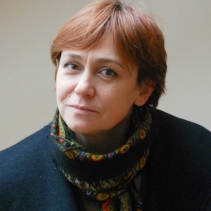 |
Jurate Jurate is our Lithuanian artist and teacher. Although she did not join the quilting to learn how to embroider, she did learn quite a bit! If society is to change its attitudes towards Roma, both sides will have to adapt. This project has provided a basis for women on both sides to reach out by hosting visits to our classroom, offering an embroidery workshop, and organizing charity events. |
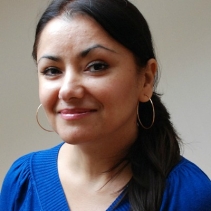 |
Oksana Oksana’s special contribution to the team has been her talent in drawing. Although she has always drawn, she is really struck by how well the designs have been realized. Furthermore, the quilting has succeeded in bringing the women together on a regular basis and building a sense of community – something that is quite rare for Roma women here. The success of the project has surprised the women, and they are enthusiastic to show the world just what they can do – they’re in the mood for change! |
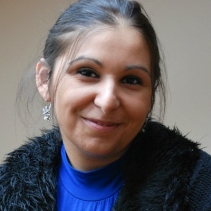 |
Aliona The quilting project was a dream come true for Aliona literally! She had seen beautiful embroidery in the films she had watched as a child and always dreamt of learning herself. But there was never the opportunity. Now that she has the chance, she plans on continuing to use her new skills, combining what she has learned from the Peace Quilt embroidery with ambitions for the fashion world. |
 |
Rouse “If you believe in your dreams, they will come true.”This is what Rouse’s mother taught her at an early age. It is very important to Rouse that the quilt is viewed by a lot of people, because it proves to the world that Romani life is not necessarily what one reads in the newspapers. She has enjoyed showing the panels to the visitors who have come to the class, as well as to her family and friends. |
 |
Anzela Anzela joined the quilting project to show the world what Roma women can accomplish. Rather than focusing on the discrimination faced by Roma every day on her panel, she wants to show the love, singing, and blooming of life. The quilting process has really inspired her to pursue another one of her dreams: fashion. Anzela wants to work on a fashion line that modernizes Romani fashion. |

